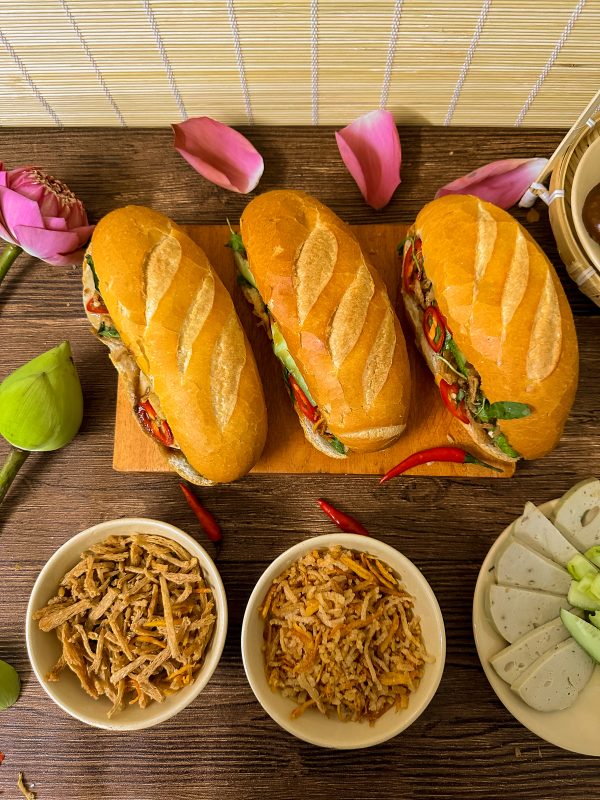Chưa phân loại
The History of Vietnamese banh mi and Its Journey of Development
Vietnamese banh mi has gained worldwide recognition. On March 24, 2020, Google featured the classic meat-filled banh mi on its homepage in over 10 countries, including Vietnam, the United States, France, and Japan. Starting as a simple street food, banh mi’s journey highlights both the blend of Eastern and Western influences and the creativity of the Vietnamese people.
1. Origins and Early History of Vietnamese banh mi
According to Associate Professor Huỳnh Quốc Thắng, banh mi has been present in Vietnam for over a century, introduced by the French and initially called the baguette.
At first, banh mi was seen as a luxury, enjoyed mainly by the upper class and the French. Locals called it “banh tay” to show its Western roots. By the early 1900s, it had become more common in Vietnam. Bakers began blending wheat and rice flour to make a softer “rice baguette,” or pain de riz. This change made it possible for more people to have banh mi with butter and a touch of sweetness for breakfast.
Vietnamese banh mi traces its origins back to the French baguette.
After the 1960s, meat-filled banh mi became a popular street food across Vietnam. In Saigon before 1975, bakeries flourished, giving rise to famous brands like Hòa Mã, Ba Lẹ, and Như Lan, which attracted long lines of customers.
2. Vietnamese Innovation and Localization of banh mi
After the French left in the mid-20th century, Vietnamese bakers continued to adapt banh mi to local tastes. Expensive French ingredients, such as butter, were replaced with homemade mayonnaise made from oil and eggs, which is often referred to as “butter” in banh mi.
Starting in the 1950s, bakers made the baguette shorter, about 30 to 40 centimeters, to fit single servings. They added cold cuts, cheese, fresh herbs, cucumbers, and chili to match local tastes. Pickled carrots and daikon also became popular, adding extra crunch to the sandwich while reducing the amount of meat.
3. Variations of Vietnamese banh mi
Experts say the history of Vietnamese banh mi is multicultural because one sandwich can show the food traditions of many different groups:
- Chinese influence: char siu pork, roast duck, shumai, and other bold-flavored fillings.
- Indian influence: chicken or goat curry sandwiches with rich, spicy flavors.
- Local Vietnamese cuisine: traditional ingredients such as pork loaf, fish cake, and shredded pork with scallion oil.
Western influence: fried eggs, liver pâté, cheese, ham, and sausage prepared in the style of Western sandwiches.

Vietnamese banh mi has been adapted to suit local tastes
There are also vegetarian options, featuring fried tofu, cooked mushrooms, or simply vegetables, all without soy sauce, for those with special dietary needs.
4. The Global Journey of Vietnamese banh mi
4.1 The “Migration” of the First banh mi Abroad
After 1975, Vietnamese immigrants brought banh mi with them as they moved to new countries. In places like the United States, France, Australia, and Canada, the sandwich began to attract local fans due to its distinctive taste. Even local French customers line up at Vietnamese bakeries to buy meat-filled banh mi with pork loaf or char siu. Today, Vietnamese banh mi is as popular in Paris as traditional baguettes.
AnB vegetarian bread is perfect for both vegetarians and non-vegetarians.
4.2 Notable Milestones in Vietnamese banh mi History
After the influence of Anthony Bourdain, international tourists visiting Vietnam make sure to try what has been called “the best sandwich in the world.” Numerous global publications have also praised banh mi in street food rankings:
The Vietnamese bakery ‘Bánh Mì Thiêng Heng,’ with its bright red sign in the heart of Paris, stands as a vivid testament to the presence of Vietnamese specialties in Europe.
- In 2012, The Guardian ranked Vietnamese banh mi second in the top 10 best street foods in the world.
- In 2014, the BBC named it “the world’s best sandwich.”
- HuffPost listed banh mi as one of the top 5 most impressive sandwiches in the world.
- In 2018, CNN called Hoi An banh mi “the king of sandwiches.”
- In 2011, the word “banh mi” was added to the Oxford English Dictionary.
- Later, it was also included in the Merriam-Webster Dictionary in the U.S.
- In 2020, Google honored banh mi with a dynamic Doodle in 10 countries, celebrating nine years since it was added to the Oxford dictionary.
The most memorable milestone in the history of Vietnamese banh mi is being honored by a Google Doodle in 10 countries.
As researcher Phan An once noted, “banh mi perfectly reflects the defining characteristics of Vietnamese culture during its process of integration.” From a French-imported baguette, Vietnamese banh mi has continuously evolved into a unique sandwich—simple, familiar, and rich in cultural pride.
The century-long journey of banh mi shows how Vietnam welcomes new ideas, makes them its own, and shares its culture with the world.






